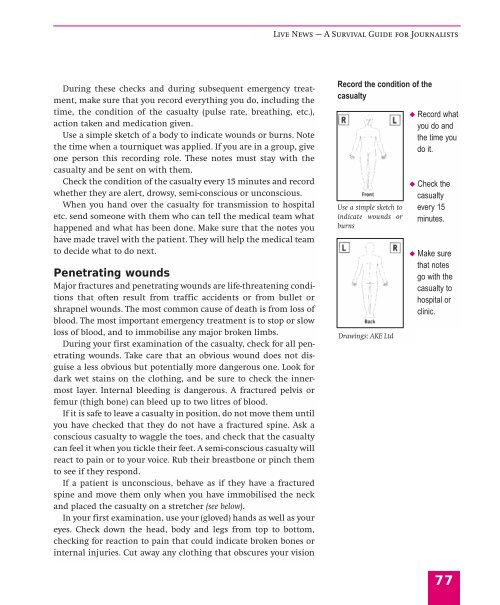Live News - A Survival Guide - International Federation of Journalists
Live News - A Survival Guide - International Federation of Journalists
Live News - A Survival Guide - International Federation of Journalists
- No tags were found...
You also want an ePaper? Increase the reach of your titles
YUMPU automatically turns print PDFs into web optimized ePapers that Google loves.
<strong>Live</strong> <strong>News</strong> — A <strong>Survival</strong> <strong>Guide</strong> for <strong>Journalists</strong>During these checks and during subsequent emergency treatment,make sure that you record everything you do, including thetime, the condition <strong>of</strong> the casualty (pulse rate, breathing, etc.),action taken and medication given.Use a simple sketch <strong>of</strong> a body to indicate wounds or burns. Notethe time when a tourniquet was applied. If you are in a group, giveone person this recording role. These notes must stay with thecasualty and be sent on with them.Check the condition <strong>of</strong> the casualty every 15 minutes and recordwhether they are alert, drowsy, semi-conscious or unconscious.When you hand over the casualty for transmission to hospitaletc. send someone with them who can tell the medical team whathappened and what has been done. Make sure that the notes youhave made travel with the patient. They will help the medical teamto decide what to do next.Penetrating woundsMajor fractures and penetrating wounds are life-threatening conditionsthat <strong>of</strong>ten result from traffic accidents or from bullet orshrapnel wounds. The most common cause <strong>of</strong> death is from loss <strong>of</strong>blood. The most important emergency treatment is to stop or slowloss <strong>of</strong> blood, and to immobilise any major broken limbs.During your first examination <strong>of</strong> the casualty, check for all penetratingwounds. Take care that an obvious wound does not disguisea less obvious but potentially more dangerous one. Look fordark wet stains on the clothing, and be sure to check the innermostlayer. Internal bleeding is dangerous. A fractured pelvis orfemur (thigh bone) can bleed up to two litres <strong>of</strong> blood.If it is safe to leave a casualty in position, do not move them untilyou have checked that they do not have a fractured spine. Ask aconscious casualty to waggle the toes, and check that the casualtycan feel it when you tickle their feet. A semi-conscious casualty willreact to pain or to your voice. Rub their breastbone or pinch themto see if they respond.If a patient is unconscious, behave as if they have a fracturedspine and move them only when you have immobilised the neckand placed the casualty on a stretcher (see below).In your first examination, use your (gloved) hands as well as youreyes. Check down the head, body and legs from top to bottom,checking for reaction to pain that could indicate broken bones orinternal injuries. Cut away any clothing that obscures your visionRecord the condition <strong>of</strong> thecasualtyUse a simple sketch toindicate wounds orburnsDrawings: AKE Ltd◆ Record whatyou do andthe time youdo it.◆ Check thecasualtyevery 15minutes.◆ Make surethat notesgo with thecasualty tohospital orclinic.77
















